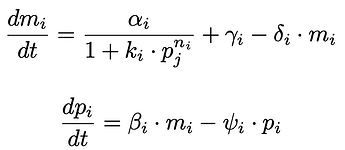Hello Pymc Community!
I am trying to obtain a ground truth posterior distribution over the parameters of a ≥10 parameter ODE model for the Repressilator system (21 parameters) as shown below:
I can make some assumptions to reduce the parameters to obtain simpler models (3, 6, 9, 12, 15, 21 parameters).
I have used pymc with the DE Metropolis Z sampler as the following snippet of minimal code shows and have gotten satisfactory ground truth distributions for the 3, 6 and 9 parameter versions of the ODE system:
@njit
def Rep_model_odeint(X, t, theta):
# unpack parameters
m1, p1, m2, p2, m3, p3 = X
b1, b2, b3 = theta
dm1dt = -m1 + (1000.0 / (1.0 + (p2)**2.0)) + 1.0
dp1dt = - b1 * (p1 - m1)
dm2dt = -m2 + (1000.0 / (1.0 + (p3)**2.0)) + 1.0
dp2dt = - b2 * (p2 - m2)
dm3dt = -m3 + (1000.0 / (1.0 + (p1)**2.0)) + 1.0
dp3dt = -b3 *(p3 - m3)
return [dm1dt, dp1dt, dm2dt, dp2dt, dm3dt, dp3dt]
# # decorator with input and output types a Pytensor double float tensors
@as_op(itypes=[pt.dvector], otypes=[pt.dmatrix])
def pytensor_forward_model_matrix_Rep_model(theta):
return odeint(func=Rep_model_odeint, y0 = initial_conditions, t = t, args=(theta,),)
initial_conditions = np.array([0.0, 2.0, 0.0, 1.0, 0.0, 3.0])
num_timesteps = 50 # Number of time steps for simulation
t = np.linspace(0, 40, num_timesteps) #Range of time of simulation
sigma = 0.5
#
with pm.Model() as Rep_model:
# Priors
# sigma = pm.Uniform("sigma", 0, 2)
b1 = pm.Uniform("b1", 0, 10)
b2 = pm.Uniform("b2", 0, 10)
b3 = pm.Uniform("b3", 0, 10)
# Ode solution function
ode_solution = pytensor_forward_model_matrix_Rep_model(
pm.math.stack([b1, b2, b3]),
)
# Likelihood
pm.Normal("Y_obs", mu=ode_solution, sigma=sigma, observed=yobs)
vars_list = list(Rep_model.values_to_rvs.keys())[:-1]
sampler = "DEMetropolisZ"
draws = tune = 5000
with Rep_model:
trace_DEMZ = pm.sample(step=[pm.DEMetropolisZ(vars_list)], tune=tune, draws=draws)
However, for the more complex versions, I have been struggling to get the ground truth estimates. Even with running this for almost a day on an HPC cluster, I get warning messages saying that the r hat is >1 or ESS is too small.
Can anyone suggest as to what all I can tinker with in order to get these estimates? Like perhaps changing proposal variance etc.?
I have already tried sampling > 10 million points, and every other sampler is extremely slower compared to the DEMZ sampler.
Any help would be highly appreciated as I am near the end of my project.
